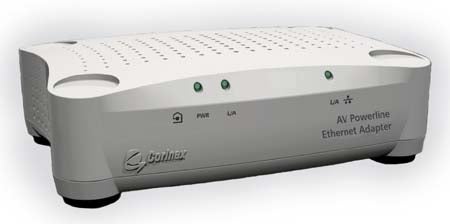Corinex AV Powerline Ethernet Adapter Review
Corinex AV Powerline Ethernet Adapter
If you want to network your home and office without a mass of Ethernet wire, but don't trust wireless, Corinex may have the answer.

Verdict
Key Specifications
- Review Price: £69.00
There’s no denying that wireless networks are the best choice for home users and small businesses that want to connect their clients but don’t want a mess of cabling getting in the way. Coverage and performance just keeps getting better with products such as Belkin’s Pre-N routers and PC Cards delivering an impressive showing in our rigorous performance tests.
There are, however, some circumstances where wireless networks are not practical or desirable such as within buildings whose structure severely interferes with reception. Security can also be a concern as although WEP and WPA encryption shuts out most snoopers some companies simply may not want sensitive data broadcast across the airwaves.

The HomePNA specification is one solution which allows networks to be created using standard telephone lines but this has fallen from favour due to poor performance. The Powerline products from Corinex take a different tack as they hitch a ride on your premises existing electrical cabling to create an Ethernet network. Performance is far better than the HomePNA 2.0 specification as Corinex claims its latest products can deliver impressive transfer rates of up to 200Mbit/sec.
On review here is the new AV Powerline Ethernet Adapter which is a sandwich-sized chunk of plastic with a single Fast Ethernet port and a power socket. These units are plugged in next to the device to be networked and the supplied Ethernet cable connects it to the adapter. You just work your way round your home or office plugging these in as required and in theory you should have a virtually wire-free network.
The adapters contain a basic Ethernet bridge and also support the 802.1p specification which allows you to create priority queues for different types of network traffic. Admittedly, home users will be unimpressed but businesses with time sensitive applications such as VoIP or video streaming could find these useful. Physical installation is indeed very simple but it gets more complex from here on as each adapter needs to be configured via its web browser management interface. Caution is advised as the adapters are all shipped with exactly the same default IP address and DHCP switched off so only one adapter at a time should be connected to avoid a conflict.
The adapter’s web interface is easy enough to navigate and your first move will be to scroll down to the network configuration section where the IP address must be changed to one that is unique on your network. Do not forget the IP address you assign to each adapter as there is no means of resetting them back to factory defaults without web access. The manual even goes as far as suggesting you place a sticky label on each unit with its address written down – a really great security idea! We were supplied with three adapters with only one at its default setting. Using the SuperScan utility (www.foundstone.com) we managed to identify the IP address of a second unit but the third was effectively out of commission.
The adapter supports two modes of operation as an access point or an end point. In the former mode you can create a list of MAC addresses that are allowed to connect to the adapter. It’s a simple security system that only permits specific systems on the same network to access the device on this adapter. A typical scenario would a be a server connected to an access point which can then service up to 32 clients connected to end point adapters. Traffic prioritisation will prove useful but the manual makes a real hash of explaining how to set it up and uses far too much technical jargon.
For testing we used a pair of Powerline adapters to link two Windows XP workstations across a standard home electrical installation. With both adapters configured as end points we achieved a network connection first time. Performance testing with the open source Iometer returned a peak transfer rate 15.2Mbit/sec while copying a 459MB collection of graphics files across the network took 210 seconds for an average speed of 17.5Mbit/sec.
Corinex provides a registry hack to improve TCP performance and we would recommend using it. After backing up the registry and applying the update we saw Iometer report a higher 21.2Mbit/sec while the same file copy was completed in 180 seconds at an average of 20.4Mbit/sec. Location plays a big part as we moved the test clients to various positions in the premises and saw performance drop by as much as 20 per cent at the greatest distances. Overall performance of the adapters is clearly well short of the quoted speeds but bear in mind that, as with wireless networking technologies, these are merely theoretical maximums which will be totally unachievable in the real world.
”’Verdict”’
The AV PowerLine Ethernet Adapter is an interesting means of implementing a network over a premises electrical wiring. It offers some useful security features and although performance is well short of the manufacturer’s claims it is on a par with 802.11g wireless. The adapters aren’t overly expensive but the documentation could be greatly improved and it’s unacceptable that an adapter cannot be reset back to factory defaults by the user if they forget its IP address.

